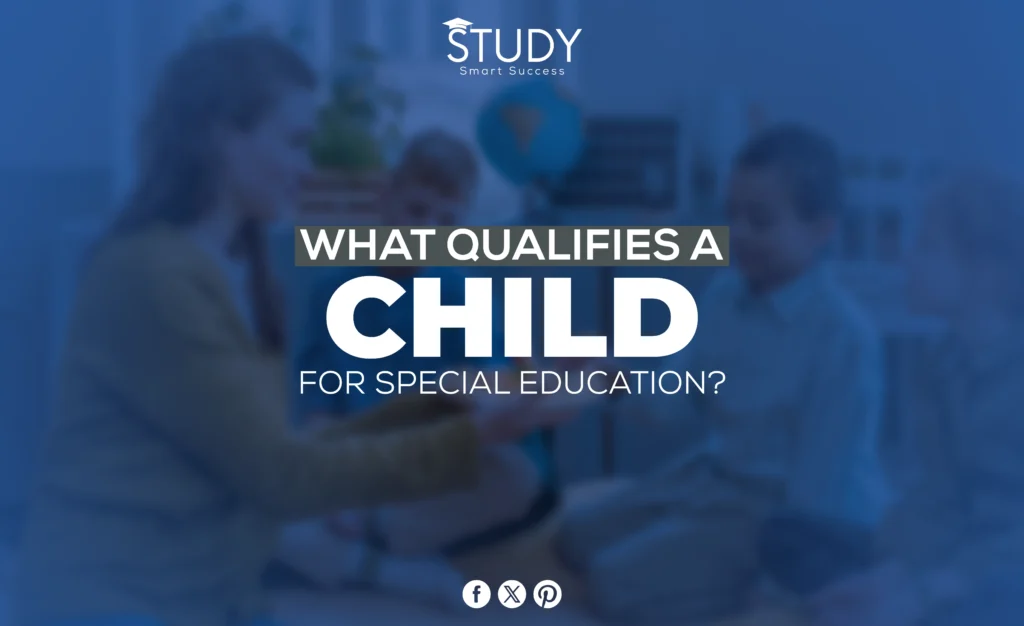Every child deserves a chance to succeed in education, regardless of their abilities or obstacles. However, typical schools may not meet the needs of some youngsters. This blog post explores special education’s complex eligibility criteria. We will explain the qualification procedure, from federal rules and regulations to individual needs evaluation.
Help us clarify special education eligibility standards to create inclusive and equal educational opportunities for all.
Importance of Identifying Qualifying Criteria
Specific special education qualifying standards are needed to help children with learning disabilities flourish academically, socially, and emotionally. Special education provides unique training, adjustments, and support to assist disabled pupils succeed in school. Understanding qualification requirements helps educators, parents, and professionals identify and advocate for special education students. Our special education eligibility review emphasizes early intervention, comprehensive assessment, and collaborative decision-making for disabled children.
Definition of Special Education
Legal Definition
Law defines special education as customized instruction for disabled students. The Individuals with Disabilities Education Act (IDEA) of the US requires special education pupils to receive a free, adequate public education (FAPE).
To give students with disabilities an education tailored to their strengths, needs, and goals, IDEA provides free specialized instruction, accommodations, related services, and supplementary aids and supports. IDEA requires constructing individualized education programs (IEPs), due process procedures, and parental involvement and collaboration to protect students with disabilities and their families.
Purpose and Goals
Special education is meant to make sure that all students, including those with disabilities, have the same chances to get an education, gain from it, and reach their full potential. Special education has many goals, some of which are:
- Access and Equity: Learning and engagement barriers are removed in special education to give disabled pupils equal access to school. It promotes inclusive learning environments where students of all talents and obstacles can succeed.
- Individualized Support: Students with disabilities have unique learning requirements and require tailored help and adjustments to address their strengths, difficulties, interests, and aspirations. To maximize student learning and development, it provides personalized instruction and interventions.
- Progress and Achievement: Special education promotes academic, social, emotional, and functional success for disabled kids. It promotes skill development, independence, self-advocacy, and self-determination to help students succeed in school and life.
Federal Laws and Regulations
Individuals with Disabilities Education Act (IDEA)
You can ensure that kids with disabilities get a free appropriate public education (FAPE) that fits their needs by following the Individuals with Disabilities Education Act (IDEA). Some critical parts of IDEA are:
- FAPE: IDEA guarantees all qualifying students with disabilities, from birth to 21, a free, appropriate, and individualized public education at public expense.
- IEP: IDEA requires disabled students to have an IEP. The IEP describes the student’s performance, annual goals, special education and related services, accommodations, and general education participation.
- Least Restrictive Environment (LRE): IDEA requires impaired pupils to be educated as much as possible with their non-disabled peers in the least restrictive environment. Students should participate in general education classes and activities as much as possible.
Section 504 of the Rehabilitation Act
Section 504 of the Rehabilitation Act is a government law that says people with disabilities can’t be discriminated against in federally funded activities or programs. Some critical parts of Section 504 are:
- Non-Discrimination: Section 504 outlaws handicap discrimination in federally funded programs, including public schools, colleges, and institutions.
- Reasonable Accommodations: To give disabled students equal access to education, Section 504 compels schools to make reasonable accommodations and modifications. Accommodations may affect curriculum, instruction, testing, or the environment.
- Evaluation and Eligibility: Section 504 does not require an IEP or specific teaching like IDEA. Instead, services are available to anyone with a physical or mental handicap significantly hindering one or more main life tasks, such as learning, walking, or seeing.
Americans with Disabilities Act (ADA)
The Americans with Disabilities Act (ADA) is a broad human rights law that says people with disabilities can’t be discriminated against in jobs, public places, transportation, and phone calls. Some important parts of the ADA are:
- Accessibility: Schools and other public institutions must give disabled people equal access and opportunities under the ADA. This includes making buildings and facilities accessible and providing supplementary aids and services for disabled people.
- Employment Protections: The ADA forbids disability discrimination in hiring, promotion, salary, and termination. Employers must make appropriate accommodations for disabled workers to perform essential tasks.
- Public Services and Programs: The ADA forbids discrimination in public services and programs, including education. Schools must give disabled students equal access to educational programs, services, and activities and make reasonable modifications.
Qualifying Criteria for Special Education
Identification Process
Several steps in the identification process for special education check to see if a student meets the requirements set by federal and state rules. Often, these steps include:
Referral:
Referrals can come from parents, teachers, school officials, or healthcare experts. Anyone concerned about a student’s learning or behavior might refer for a special education examination.
Evaluation:
After receiving a recommendation, the school evaluates the student’s academic, developmental, and functional skills. This evaluation may examine cognitive abilities, intellectual accomplishment, language and communication skills, social-emotional functioning, and adaptive behavior. A multidisciplinary team of educators, psychologists, speech-language pathologists, occupational therapists, and others evaluates based on the student’s needs.
Determination of Eligibility:
The eligibility team decides if the child qualifies for IDEA special education after the evaluation. A verified impairment that hinders educational performance and requires extra instruction and support to access the curriculum and succeed in school qualifies students for special education. Learning, intellectual, emotional, speech, language, autism spectrum disorder, traumatic brain injury, visual, hearing, IDEA covers orthopaedic and other health impairments.
Development of an Individualized Education Program (IEP):
Those eligible for special education receive an Individualized Education Program (IEP). The IEP describes the student’s current performance, annual goals, special education and related services, accommodations and modifications, general education participation, transition services (for students 16 and older), and other supports needed to meet their educational needs. Parents, educators, and other professionals collaborate to create the IEP, which is evaluated and updated annually to reflect the student’s development and changing needs.
Placement Decision:
After creating the IEP, the placement decision determined the best educational location and services for the student to receive special education. Based on the student’s needs and the least restrictive environment (LRE), placement may be in a general education classroom with supplementary aids and services, a special education classroom, or a specialized program or school.
Schools can enable disabled students to access a free appropriate public education (FAPE) and accomplish their educational goals by following a systematic and thorough identification process. Parents, educators, and other professionals must work together to identify and meet the student’s needs.
Assessing Individual Needs
Individualized Education Program (IEP)
Individualized Education Programs (IEPs) are legally enforceable for pupils who qualify for special education under the Individuals with Disabilities Education Act. The IEP describes the student’s learning needs, academic goals, special education, and related services needed to succeed. Important IEP components:
- Present Levels of Performance: The IEP describes the student’s academic and functional performance, strengths, shortcomings, and needs. It sets the stage for goals and initiatives.
- Annual Goals and Objectives: IEPs provide measurable annual goals that address the student’s needs and meet grade-level academic expectations. SMART goals meet students’ academic, functional, and behavioral needs.
- Special Education and Related Services: The IEP outlines the special education and related services needed to help students achieve their goals. Specialized training, speech-language, occupational, physical, counseling, assistive technology, and accommodations or adjustments may be required.
504 Plan
A 504 Plan, named after Section 504 of the Rehabilitation Act of 1973, provides accommodations and support to students with disabilities who do not qualify for IDEA special education services but need them to access the general education curriculum. A 504 Plan does not require specific training or services like an IEP.
Instead, it provides accommodations, adaptations, and other assistance to meet the student’s disability requirements in general education. A 504 Plan may provide extra test time, priority seating, modified assignments, assistive technology, and environmental adjustments.
Determining Accommodations and Modifications
Disability adjustments and adaptations are determined by a collaborative approach that examines the student’s skills, requirements, preferences, and learning environment. Accommodations remove learning barriers and let students demonstrate their knowledge and skills. Accommodations include:
- Extended time on tests or assignments
- Use of assistive technology (e.g., text-to-speech software)
- Preferential seating in the classroom
- Modified assignments or testing formats
- Breaks during instruction or testing
- Visual supports (e.g., graphic organizers, visual schedules)
- Simplified language or instructions
- Note-taking assistance
- Alternative assessment methods
- Environmental modifications (e.g., noise reduction headphones)
Curriculum or instructional content is modified to meet student needs and abilities. Modifications change curricular content or expectations, unlike accommodations. Modifications may include:
- Reducing the number of assignments or questions
- Simplifying reading materials or assignments
- Using alternative grading criteria
- Providing alternate assessment options
- Adjusting the pacing or complexity of instruction
Assessment, educator-support staff teamwork, and student and family participation are needed to determine appropriate adjustments and modifications. Students receive tailored support to optimize learning and success while developing independence and self-advocacy.
Collaboration between Parents, Educators, and Professionals
Importance of Parental Involvement
Parents play a significant role in exceptional education decision-making. Fathers’ and mothers’ knowledge of their child’s skills, needs, and preferences is vital for effective educational strategies. Mother’s and Father’s help educators identify a child’s strengths, weaknesses, and learning styles, allowing them to customize treatments.
Parents also fight for the rights and wants of their children in school. Parents involved in their children’s special education help them do well in school, with friends, and with their feelings.
Role of Teachers and School Staff
- Instructional Planning and Delivery: Teachers and staff must implement students’ IEPs or 504 Plans, including accommodations, modifications, and specialized teaching.
- Monitoring Progress: Teachers assess students’ progress toward goals and objectives and alter education and support to meet new needs and foster growth.
- Communication and Collaboration: Teachers help parents, teachers, and other education professionals communicate and collaborate. Open communication keeps everyone informed and working together to support the student.
Collaboration with Specialists and Therapists
Speech-language pathologists, occupational therapists, psychologists, and behavior experts work together to meet students’ different needs. Professionals can collaborate to help disabled pupils thrive academically, socially, emotionally, and behaviorally. This collaboration ensures solutions are targeted to each student’s needs, supporting well-being and school and life success.
Professional development and training help educators and specialists improve teamwork, learn best practices, and stay current on special education research and solutions.
Parents, educators, and professionals can work together to establish a supportive and inclusive learning environment that helps students with various learning needs succeed academically and socially. Teamwork ensures that children receive full support and services to succeed academically and personally.
Conclusion
In conclusion, special education eligibility is determined by a thorough assessment of the student’s disability, academic achievement, functional abilities, and educational progress. Evaluations, IEPs, and 504 plans help pupils access the curriculum and achieve in school.
Parents, educators, and professionals should actively seek help and resources to ensure disabled pupils receive complete treatment. Parents, educators, experts, and therapists must work together to provide a supportive and inclusive learning environment that helps all students succeed. We can defend the rights of disabled students and give them the skills and opportunities they need to succeed academically, socially, and emotionally.



